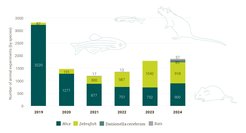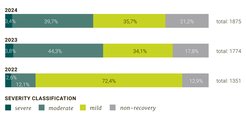Animals in research in numbers
Overview on animals in research at the Max Planck Institute for Infection Biology
In 2024, 1875 animals were used for scientific purposes at the Max Planck Institute for Infection Biology. The number of laboratory animals remains almost constant compared to the previous year (1774 animals). The majority of the animals used were mice (900 animals) and zebrafish (918 animals). As in 2021 and 2022, rats were also used for experiments in 2024 (57 animals). For the first time, experiments were carried out with the fish species Danionella cerebrum in 2024 (85 animals). Like zebrafish, these small fish are used in tuberculosis research. You can find a brief portrait on our experimental animals page.
Animal experiments in 2021, 2022, and 2023

Severity levels of animal experiments
Together with the annual reporting of laboratory animal numbers, we submit information of burden and severity levels of animal experiments to the authorities (Landesamt für Gesundheit und Soziales Berlin). The classification of stress levels are defined in Directive 2010/63/EU of the European Parliament and of the Council of 22 September 2010 on the protection of animals used for scientific purposes.
The exact definitions at a glance are:
Non-recovery: procedures in which animals are killed for scientific purposes without pre-treatment, or experiments performed entirely under general anaesthesia from which the animal shall not recover consciousness, are classified as "non-recovery". The former accounts for by far the largest proportion of animals killed for experimental purposes and, although not considered an animal experiment under the Animal Welfare Act, is included in the annual laboratory animal report as a loading level of "non-recovery".
Mild: Procedures that cause short-term minor pain, suffering or harm to animals and procedures that do not significantly affect the welfare or general condition of animals are classified as "mild".
Moderate: procedures that cause short-term moderate pain, suffering, or harm to animals, or long-term minor pain, and procedures that cause moderate impairment to the welfare or general condition of animals are classified as "moderate".
Severe: Procedures that cause severe pain, suffering, or harm to animals, or prolonged moderate pain, suffering, or harm, and procedures that cause severe impairment of the welfare or general condition of the animals are classified as "severe".
In over 75% of all animal experiments at MPIIB in 2023, animals were subjected to only minor stress—classified as „mild“. Another large proportion of the animals reported were killed painlessly for scientific purposes, for example to take cell or tissue samples. They are included in the statistics under "non-recovery." A very small number of animals were severely stressed in experiments, with only 3.4% of experiments falling into this category. In these experiments, the scientists are obliged to monitor the stress closely and to reduce it as far as possible by appropriate methods (e.g. special feed and painkillers).


